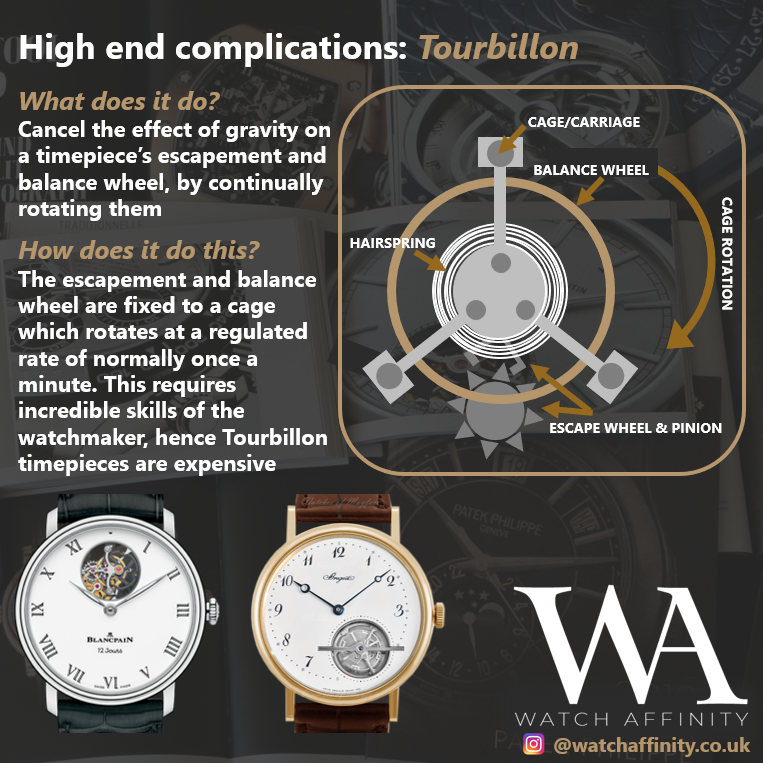In the world of luxury watches, eyebrows might often be raised when looking at a timepiece with a commanding purchase price. Can it really be worth that much? Notwithstanding pieces made from precious metals being an obvious factor, one other common – yet not always as obvious – factor is the inclusion of specific high-end complications within the calibre. In this three-part series, we will explore some of the complications available in the higher end of the market, what they are, and what it is about them that lends high-end manufactures to be able to command such high prices.
We will start this article with perhaps the most famous and mesmerising: the tourbillon complication…
The Tourbillon Complication
Invented by famed watchmaker Abraham-Louis Breguet, the tourbillon was first invented in around 1795 with the patent filed in 1801. During this era, the personal timepiece of choice was a pocket watch, and over time, Breguet realised that with his mechanical timepieces being held in the same vertical position in a client’s pocket, the continual gravitational pull of the Earth could have a detrimental effect on the accuracy of the timepiece by, over time, altering the motion of the escapement and balance wheel.

Tourbillon complication - top left of this image
For an analogous example, consider the hands on a modern wall-clock: for the minute hand to move clockwise between the 12 o’clock position and 6 o’clock position will naturally be easier than going back up from the 6 o’clock position to 12 o’clock, where it is moving against the pull of gravity.
At the time, Breguet posited a new approach to counteract this by creating a complication which would enable both the escapement and balance wheel to be rotated continually as one within the timepiece itself, such that whilst the timepiece might remain static, the escapement and balance wheel would continue to rotate. What this motion achieves is to average out the detrimental effects of gravity on the timepiece, and in so doing cancels out any detrimental alterations to the accuracy of the timepiece caused by gravity. This would provide a greater reliability of accuracy in a tourbillon timepiece versus a timepiece without. Breguet named his new complication the “tourbillon”, the French word for whirlwind.
With modern timepieces, any additional accuracy afforded by the tourbillon is realistically negligible owing to advancements in technology, rendering the complication itself essentially moot. However, what the complication continues to represent today is a demonstration of high-end watchmaking nous and savoir-faire; the tourbillon complication itself comprises 40 or more individual components alone. Each of these tiny parts are hand-finished to the highest quality by remarkable artisans, before they are brought together and compiled to create the tourbillon by the hands of the most highly skilled watchmakers in the world.
Since Breguet’s original invention, other watchmakers have taken the concept further, and today it has evolved such that there are flying tourbillons, double and triple axis tourbillons, gyro tourbillons, and even timepieces with multiple tourbillons in a single piece. The recent MB&F Thunderdome by Eric Coudray and Kari Voutilainen is a fantastic example of the evolution of the tourbillon’s concept: here, the movement’s regulating mechanism features three fast-rotating axes that are all on different planes, with different speeds, and the result is truly a sight to behold. In total, this movement has an incredible 413 individual components. Check out the official MB&F video here:
In today’s market, a ‘standard’ (for want of another phrase) tourbillon timepiece will likely cost you in the region of £40,000 to £50,000, although, that being said, in 2016 TAG Heuer released the Heuer 02T tourbillon which retails for around £15,000, making it one of the most accessible tourbillons available from a luxury brand.
There are also even more accessible tourbillon watches produced by Swiss independent brand Horage, and Japanese brand Zeroo Time.
When adorned with a tourbillon, a timepiece instantly stands out as being one of exceptionally high quality, and having been brought to life by a watchmaker of incredible talent. It is this which renders a tourbillon timepiece held in such a high regard, and a standout piece in any collection, and why any collector would love to be able to point to one of their own.
To try and help show the fundamentals of the tourbillon in an easy to digest summary, we have created an infographic to serve as a quick introduction to the tourbillon:

For any questions, please get in touch via our Contact page, or via our Instagram.
You might also be interested in:
- “It’s complicated” Part 2: an introduction to the Perpetual Calendar
- Spotlight: Horage
- Spotlight: Zeroo Time T4 Tourbillon
- Influential Watchmakers: Abraham-Louis Breguet
- Watch Stationery and Gift Ideas
- Watch Books, Watch Boxes and more at the Watch Affinity Shop on Amazon (commissions earned)
As an Amazon Associate, I earn from qualifying purchases – thank you for your support

